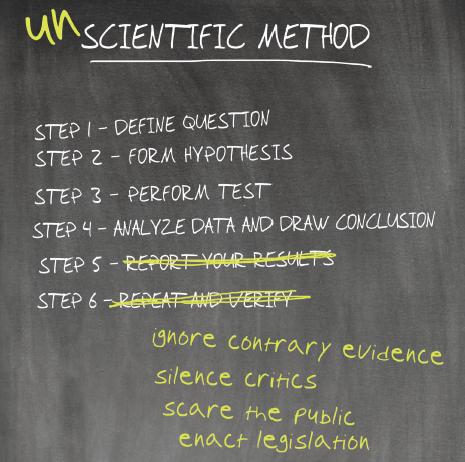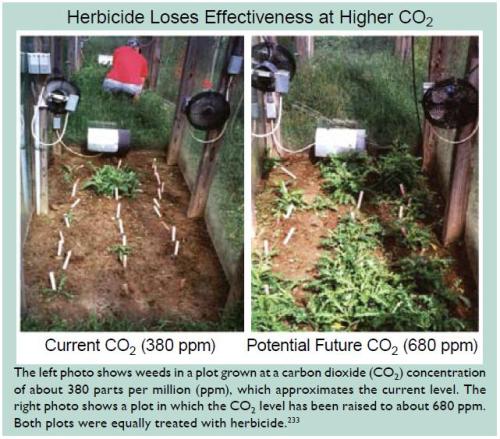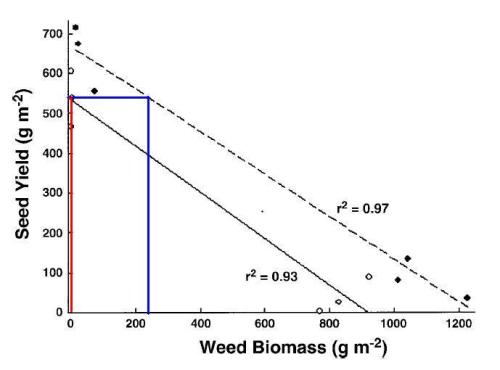The USA has its own Climate Change propaganda. The latest is Obama’s first big scientific report, Global Climate Change Impacts in the United States, signed off by Obama’s appointed President’s Science Advisor, John Holdren, the neo-Malthusian who has espoused forcible sterilization and abortion for reducing the US population. As expected, it’s a classic but crude piece of propaganda peppered with images that are designed to scare, but which are unrelated to the matter under consideration – for example pictures of floods from Hurricane Katrina, which has nothing whatsoever to do with climate change, but which was merely the result of a hurricane making landfall directly on New Orleans. The Space and Science Research Center in Florida put out a press release on July 13 with a call for Holdren and NOAA Administrator Jane Lubchenko to be removed from office because
These two individuals and other agency heads orchestrated and then signed off on the recently released government report, Global Climate Change Impacts in the United States. This report was a piece of blatant, politically motivated bad science and pure propaganda…
And in a letter to Senator Boxer, the SSRC opine that it is
an international embarrassment of American scientific expertise and is so full of misleading data, false assumptions, and invalid conclusions that it simply cannot be relied upon as a policy making reference.
The report cites 569 references, but how many readers are going to go to the trouble of looking any of them up to discover that they don’t support the position of the text, or have been so selectively quoted that they are relied on to say the opposite to what was meant?

We can’t deal with the whole report, so we will mention one example from the chapter on agriculture (PDF here) as we have been considering the effects of elevated CO2 on plants. This example will demonstrate the lying propaganda, and the disregard and crafty twisting of the evidence; and this example is typical of the whole report, which is a compendium of lies.
The poster boy of the agricultural section of the report is the following image, which also appears on the associated website. The report text states
The most widely used herbicide in the United States, glyphosate (RoundUp®), loses its efficacy on weeds grown at carbon dioxide levels that are projected to occur in the coming decades (see photos below).
Higher concentrations of the chemical and more frequent spraying thus will be needed, increasing economic and environmental costs associated with chemical use.

What this is supposed to show is that as CO2 increases, the effectiveness of a common herbicide decreases. Notice anything strange? The experiment is completely unrepresentative of an agricultural situation since it is evident from the picture that there are no crops present. Well, who sows and grows fields of weeds, and who wastes time and money spraying weeds with herbicide where there are no crops growing? Who cares about weeds where crops aren’t grown? No-one.
Don’t be deceived. What the picture actually shows is that weeds, like all plants, thrive under elevated CO2, can better utilize available resources, and can overcome stresses better (in this case, the application of herbicide, which is an extreme stress). This is expected, and we pointed this out in previous posts (World Food Supplies and Carbon Emissions, and Photosynthesis and CO2 Enrichment). The picture says nothing whatsoever about what would happen to the weeds under herbicide stress when they have to compete for the same resources (water, nutrients, light, CO2 etc) as herbicide-resistant crops growing in the same patch. What we find in the real world (as we will demonstrate below) is that in a competitive environment (which is the only real-world agricultural scenario worth considering) the fertilizing effects of enhanced CO2 on crops far outweigh any slight mitigation of herbicide stress on weeds. The result is that in elevated CO2 environments, crop yield is far higher for a given application of herbicide, or alternatively for a given crop yield the herbicide requirement is considerably reduced. Thus the report is lying, the scientists who compiled it are lying, and they know very well that they are lying. The trouble is, we’re not supposed to be informed well enough to know it. We will now prove it.
The reference alluded to in the report is Wolfe, W., L. Ziska, C. Petzoldt, A. Seaman, L. Chase, and K.Hayhoe, 2007: Projected change in climate thresholds in the northeastern U.S.: implications for crops, pests, livestock, and farmers. Mitigation and Adaptation Strategies for Global Change, 13(5-6), 555-575. This is an overview report without any rigorous detail or field results, and one that references lots of other works. All this really says about the matter is
For the United States and many developed countries, chemical methodologies allow for cheap, effective weed control. Actually, a single herbicide, glyphosate (commercially sold as “Round-Up”), is so effective in controlling weeds that more than three-quarters of the U.S. soybean crop, and over a third of the U.S. corn crop have been genetically modified to be glyphosate resistant (e.g., Gaskell et al. 1999).
Unfortunately, there are also an increasing number of studies (Ziska et al. 1999, 2004; Ziska and Teasdale 2000; Ziska and Goins 2006a) that demonstrate a decline in chemical efficacy with rising CO2 per se. Given the evidence from field and laboratory trials, it appears that declining efficacy of herbicides with increasing CO2 is very likely to affect the environmental and economic cost of pesticide usage (Ziska et al. 1999; Ziska and Teasdale 2000).
Firstly, notice the little words ‘per se’ in the critical sentence. We don’t doubt that there is a decline in herbicide efficacy with increasing CO2 because we have always said that CO2 helps plants overcome stresses. Plants are more resistant to drought, heat, cold and salinity under elevated CO2 as well! But the ‘per se’ prohibits conclusions being drawn about what happens in competitive environments, which are the only environments worth considering in a section on agricultural impacts. Note that the report states that this change in efficacy will affect the environmental and economic cost, but it does not say whether this will be an increase or a decrease. Yet the propagandist US report twists this to
Higher concentrations of the chemical and more frequent spraying thus will be needed, increasing economic and environmental costs associated with chemical use [emphasis mine].
Happily, the report by Wolfe et al references a report by Ziska and Goins that gets us to the experimental data we need on competition: Elevated Atmospheric Carbon Dioxide and Weed Populations in Glyphosate Treated Soybean, CROP SCIENCE, VOL. 46, MAY–JUNE 2006. Among other things, this report gives us hard data concerning soybean yields in competition with weeds at normal and higher CO2. To simulate a ‘worst case’ scenario, the crop was sown with a broad spectrum of weeds with different photosynthetic pathways: broadleaf C3, broadleaf C4 and grassy C4.
We first need to consider the effects of increased weed biomass on seed yield, and this is shown below (all data taken from Ziska and Goins):

This is a typical result for competition between populations for the same resources where the level of stress applies differently to different populations. The cluster of points at bottom right represents the results when no herbicide was applied, and those at the top left represent the results with herbicide applied (weeds severely inhibited). The lower bold line is for normal CO2 levels (380 ppm) and the upper dashed trace shows the condition at higher CO2 (630 ppm). It is immediately obvious that the CO2 enrichment gives a substantial seed yield improvement at any given level of weed biomass.
Below is the amount of weed biomass produced under different CO2 conditions without herbicide spraying.

There is evident competition between the weeds here as well. As we showed in former posts, C3 plants are starved of CO2 at current levels but the C3 photosynthetic pathway will tend to out-compete C4 at elevated CO2. Clearly the C3 broadleaf weeds do very well at high CO2, especially at the expense of C4 grasses, but are squeezed out by C4 weeds at normal CO2. Adding up the total biomass, however, we see that the weed biomass is increased from around 750g to 1125g per square metre from normal to high CO2. If we plot these on the competition graph (see below) we see that the yield is equally poor at both levels of CO2. We conclude that no-one is likely to grow this herbicide-resistant soybean with this battery of weeds without the application of herbicide. Of course, on this trial the broad spectrum of weeds was deliberately sown with the crops, which is not a realistic agricultural scenario anyway, except in the parable of the wheat and tares.
Now consider the effect of spraying with herbicide (i.e. adding a stress to the weeds, but not to the crops). Note carefully the change of scale on the vertical axis!!

Weeds are almost completely eliminated except for C3 weeds at high CO2. But note that the total weed biomass is still negligible at elevated CO2, a mere 36 grams per square metre. As expected, herbicide-stressed weeds compete very poorly with herbicide-resistant C3 crops (e.g. soybean) flourishing under enhanced CO2. By inspecting the competition graph below, we can see that about 240g of weed biomass can be tolerated at elevated CO2 for the same crop yield at normal CO2. Since this is over six times the weed biomass (36g) arising from a standard herbicide application at elevated CO2, it follows that a substantial reduction in herbicide use is possible at elevated CO2 for the same crop yield, as shown below.

Alternatively, consider a standard application of herbicide:

Here, even with the production of a little weed biomass (a mere 36g per sq.m), the crop seed yield has increased from 540 to 650g per sq.m with elevated CO2, a 20% improvement.
We thus prove directly from the research data that with elevated CO2, and in competition with a broad spectrum of weeds deliberately sown, soybean yields increase by 20% for the same usage of herbicide, and yields are the same at considerably reduced usage of herbicide.
This is the complete opposite of what is claimed in the US report, and is a typical example of how the climate lobby are deceiving us. As the famous astronomer Halton Arp declared
The most damaging aspect of science today is widely promulgated theories that are contradicted by observation and experiment. In both cases, a story is mandated by authority and then defended by educational, economic, and sociopolitical agencies.
Of course, none of this even takes into account the improvements in pesticides and crops that we can expect to see over the next 50 years. Herbicides will be developed that are more effective than glyphosate, and crops will be specially bred and modified to leverage the wonderful benefits of increased CO2. Taken together, food crops will be increasingly able to out-compete weeds, and yields will increase to a tremendous extent with scope for reducing use of herbicides as atmospheric CO2 increases.
I just want to say how much I enjoyed reading this,thanks for the enlightenment.
Having lived now 6o years in Western Pennsylvania, I remember most of the extremes of weather, both summer and winter. I can say that I can see no difference in the climate. Since I’m older, I prefer warmer over cooler.
It is fact that humankind has prospered more during the times of a warmer climate in earths history. Many more people die due to cold in winter opposed to heat in summer.
Our green leaf friends, grass,trees, and flowers support us in so many ways. They can not survive with out CO2 just as we humans can not survive with out oxygen.
I personally feel that there is a good side to global warming and the increase of CO2, if in fact that is the case. However, I personally think that we are in for a cooling spell, maybe 10 – 20 years. I hope I’m wrong because that could be very bad for us humans, less food to go around if that happens.
Professor Freeman Dyson at Princeton is a scientist that I have a lot of faith in, I really think he knows what he is talking about and more people should be listening to what he has to say. Another is Professor Robert M. Carter at James Cook University.
Something I like you to know is that I am a advocate of alternative energy. You might wonder why I’m not on board with these environmentalists, well what I see is a few scientist have gotten in bed with the politicians and true science has been averted to meet their agenda.
I like to say that there are thousands of good scientists and laypeople working daily to bring us the truth. In my work along with others here in the area, we have found answers to high energy price. I,m not concerned with the environment other that we should all be good stuarts. And strong belief in what we can accomplish with out government.
If I told you that with the help of a few friends we have solved the problem of growing energy demands, you might laugh, it OK we really don’t care! There is no secret, it’s all right in front of you on you computer screen. The world is my classroom and class is in secession. It all there waiting to be discover.
How sad that so many of us have forgotten about what it must have been like to come to this land call America. We may have to return to that lesson someday. The real worry to me is not Global Warming, but Global Cooling, if these Global Warming Scientists are wrong, millions will die because we have only planned in one direction.
My father once told me to plan for the worst and hope for the best. So many today do the opposite and are ill equipped to handle problems that come up, expecting that government will bail them out. If you believe that the grocery store is your source of food, someday you may be in for a rude awaking. It’s like the lady that said, “Who cares about the dairy farmers, I get my milk from the Grocery store”.
No need to worry though, faith in the future gives you power in the present.
Most alarming of all is that the US Government and the worldwide ruling priests of econuttiness and Darwinism have control of the academic world and their iron grip extends to include most of the media and various governmental agencies. This current US Administration is the worst complilation of devout econuts and liars and malthusian haters ever to be part of our government.
Thank God for your posts. They do not come out often, but when they do come they are brilliant!
They even do the unscientific method as you suggest.
The general procedure as I see it is.
Form a general theory (rather vague)
Form some inexact quantitatively physically meaningless parameters (totally opposite to regular science) (fine in a qualitative sense but always used quantitatively)
Form hypotheses using those parameters (obviously physically meaningless- do not take account of the whole system)
Make assumptions (which are never stated ever again)
Gather data
Make exact pronouncements- don’t do any error analysis or confidence allowance. Don’t check your assumptions or use fraudelant studies – such as Mann’s hockey stick.
Use science of the early era where it was only had academic value- they weren’t trying to provide basis for changing the world.
Also gather studies which fine within their original scope but exceed that scope but don’t take any account for that.
Say vague and meaningless things like most likely ….